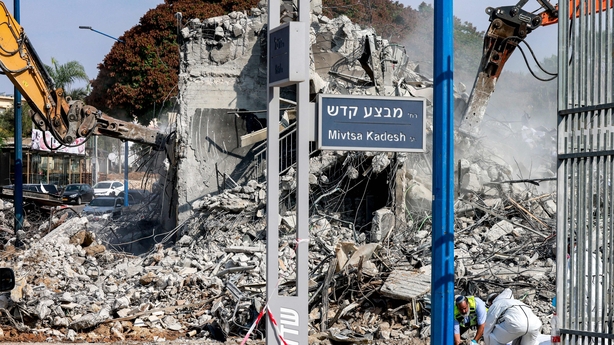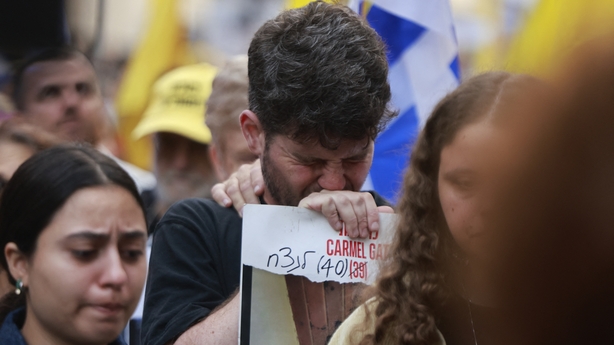When Haim Fleischer turned on his television at 8am, his first question was: where the f**k is the army?
"Still, at noon, we asked the same question," Mr Fleischer told RTÉ News. "Where is the army?"
There was no reply. And he still has not received the answer.
One year ago today, more than 2,000 Hamas fighters from Gaza swept into Israel.
At dawn, under the cover of thousands of rockets fired from Gaza, they breached the border fence at 29 separate points, using bulldozers, hang gliders and motorbikes.
Over the course of several hours, they rampaged through southern Israel, killing more than 1,100 people in towns and military bases.
The vast majority of those killed - almost 700 - were Israeli civilians.
They died at home, walking on the street, and while dancing at a music festival.
Almost 300 soldiers and 40 police officers lost their lives defending Israeli territory.
Hamas took more than 250 hostages, including the bodies of 37 people taken to Gaza after they had been killed.

Some 97 of the 250 people taken on 7 October are thought to remain in Gaza.
It was the deadliest day in Israel's 76-year history.
But it was also day one of a war that has shaken the world.
Soon after Hamas struck, Israel began bombarding Gaza, vowing to totally obliterate the group.
Within weeks, Israel launched a full-scale invasion of the enclave, and conducted one of the deadliest and most destructive bombing campaigns of all time.
In the year since 7 October, more than 40,000 Gazans have been killed and nearly 100,000 wounded, according to the Hamas-run health ministry in Gaza.
While many have cast doubt on the accuracy of the figures, most accept that tens of thousands have been killed.
More than half of Gaza's homes, 65% of roads, and 90% of school buildings have either been damaged or destroyed entirely.
Of Gaza’s 36 hospitals, just 17 remain partially functional, putting a huge strain on the supply of medical care in an enclave that has seen unprecedented demand for treatment.
It has been one year since the beginning of a new, unpredictable chapter in the Middle East.
But, for residents of southern Israel, it has also been a year without answers.
"I'm not sure you want to hear my opinion about the government," Mr Fleischer said at the site of the Nova music festival, where 364 people were killed by Hamas.
"They should be gone. They should retire.
"They should establish a committee to investigate what happened before 7 October."
Shai Ben-Yaish, as one member of the army on 7 October, can account for himself.
Early on 7 October, his phone rang.
"I'm the commander of my unit. So I'm the first one to go," Mr Ben-Yaish said at his home in Sderot.
"And they told me right away, that in this tiny forest that's behind my home, it was full of terrorists."
Sderot is just 1km from the border with Gaza. From a hill on the edge of the town, you can see make out the rubble and devastation on the northernmost edges of the enclave.
On 7 October, it took the Israeli military more than 12 hours to regain control of the town.

During the Battle of Sderot, as it is known, a minibus carrying elderly passengers pulled in at the side of the road due to a flat tyre and was attacked by Hamas militants. All 15 men and women on board were killed.
The terrorists also took control of the city's police station. The only way to reclaim it was to raze it: the Israeli military bulldozed it to ensure that all of the militants inside were killed.
Mr Ben-Yaish battled Hamas fighters for hours.
"I've looked at their eyes during combat and after it, when they were on their last second before they passed away, I don't remember eyes," he said.
"And I've looked inside to to hell."
He would soon get a look inside his own personal hell.
"I got this phone call from the Kibbutz [where his sister lived]. They said that my sister, her husband, and their 14-year-old – that they were murdered in their house."
After learning of her death, Mr Ben-Yaish went to his sister's house.
The house had been burned. Everything was dark.
"I saw the place where they were killed inside the shelter, in their home. I saw the bullets," he said.
Residents of Sderot, like many towns in the south, have only returned to their homes in recent months.
But Mr Ben-Yaish never left – he stayed in the home he has lived in since he was born 56 years ago.
Not leaving is part of his personal brand - he is an ever-present force in the town.
And he is running to be mayor.
"I'm trying to make peace, wherever I go, between people, between groups. This is my neighbourhood," he said.
"After 7 October, I realised that this is the most important decision that I took – to run for mayor."
He is hoping to bring the town together. It is one of the many towns and kibbutzim in southern Israel that refused to take part in the government's official memorial ceremony.
Just two, in fact, agreed to take part. There is much anger about the security failings that led to 7 October, and at the government's handling of the war.
To most, Prime Minister Benjamin Netanyahu has priortised the total desctruction of Hamas – and the drawing out of the war – over the return of the hostages.
But anger at the government should not be mistaken for pro-Palestinian sentiment, even in the south – which had long been that way inclined.

It is in the south that cross-border initiatives prospered in the decades that proceeded 7 October.
Meira Yadgar, a retired teacher, used to work on some of those initiatives.
She now sees things very differently.
"I can't think of the Palestinians, really. I have to think of my own survival, because we are surrounded by so many enemies," Ms Yadgar said.
That Israel is "surrounded" is a common refrain here. Mr Netanyahu told the UN General Assembly the same thing – that it was encircled by enemies who wanted to destroy it.
His comment drew the ire of the foreign minister of Jordan, whose response went viral.
"The Israeli prime minister came here today and said that Israel is surrounded by those who want to destroy it," Ayman Safadi said.
"We’re here - members of the Muslim-Arab committee, mandated by 57 Arab and Muslim countries - and I can tell you very unequivocally, all of us are willing to guarantee the security of Israel in the context of Israel ending the occupation and allowing for the emergence of a Palestinian state."
But you can at least understand why Israelis might feel this way.
In July, the new Iranian president was sworn in to chants of "Death to Israel".
And Iran supports a number of proxy groups: Hamas in Gaza, Hezbollah in Lebanon, the Houthis in Yemen, and the Islamic Resistance in Iraq. All have tried to strike Israel in recent weeks and months.
After walking through a dense warren of portraits on wooden poles at the Nova festival site, Ms Yadgar said that she does not care about the deaths of more than 40,000 Palestinians in Gaza.
"To be really honest, whereas in the past I always thought about them, today, I don't think about them. I don't care," she said.
The portraits depict the mostly young people who came there to dance last October - but never made it home.
"After what they have done to our young people, to the people all around the Kibbutzim here," she said, "I don't care about them."





